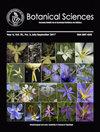对菲特考伊哺乳动物种复合体(仙人掌科)的形态分析揭示了一种来自墨西哥哈利斯科州的新种
IF 0.7
4区 生物学
Q3 PLANT SCIENCES
引用次数: 2
摘要
背景:Mammillaria系列Stylothelae(仙人掌科)包括16个分类群,主要分布在Chihuahuan沙漠(CD)与Sierra Madre Oriental和Transmexican火山带(TVB)的边界。在哈利斯科,四种粉红色的花出现在CD的西南端,在那里它与TVB相遇。三个与菲特卡伊M.fittkaui(M.fittkaoi复合体)亲缘的物种的边界和识别存在争议。问题:是否应该将菲特凯长毛象物种复合体的分类群视为物种?研究种:四个粉红色花的长毛象系列Stylothelae(M.fittkaui物种复合体)和玉米粉虱属作为比较种。研究地点:墨西哥西部。方法:从三个粉红色花种、一个Mammillaria sp.和M.zeilmanniana的模式位置采集标本的六个形态特征。我们对每组的六个性状进行了排列多元方差分析,并使用判别分析来评估物种之间的形态变异,并确定每个个体的正确分类。结果:分析确定了菲特凯毛母复合体中四个具有统计学意义的明确形态组。我们识别了M.fittkaui、M.limonensis和M.manana为物种,并将M.arreolae描述为哈利斯科的一个新种。结论:在仙人掌科中,形态计量学有助于建立物种边界。fittkaui长毛象复合体包括四个物种。arreolae贝母与其他物种的不同之处在于块茎、花朵和果实较短。此外,它在每个乳晕形成一个以上的钩状中央棘。本文章由计算机程序翻译,如有差异,请以英文原文为准。
A morphological analysis of the Mammillaria fittkaui species complex (Cactaceae) reveals a new species from Jalisco, México
Background: The Mammillaria series Stylothelae (Cactaceae) includes 16 taxa distributed mostly among the limits of the Chihuahuan Desert (CD) with the Sierra Madre Oriental and the Transmexican Volcanic Belt (TVB). In Jalisco, four pink flowered species occur at the southwestern end of the CD where it meets the TVB. The boundaries and recognition of three species related with M. fittkaui (M. fittkaui complex) are debatable.
Question: Should the taxa of the Mammillaria fittkaui species complex be considered as species?
Studied species: Four pink flowered Mammillaria series Stylothelae (M. fittkaui species complex) and M. zeilmanniana as comparative species.
Study site: Western Mexico.
Methods: Six morphological characters were sampled in specimens from the type locations of three pink flowered species, one locality of Mammillaria sp., and M. zeilmanniana. We used a permutational multivariate analysis of variance on six characters of each of the groups and a discriminant analysis to evaluate the morphological variation among species and to determine the correct classification of each individual.
Results: The analyses identified four well defined morphological groups with statistical significance within the Mammillaria fittkaui complex. We recognized M. fittkaui, M. limonensis, and M. manana as species and here describe M. arreolae as a new species from Jalisco.
Conclusions: In Cactaceae, morphometry has been useful to establish species boundaries. The Mammillaria fittkaui complex includes four species. Mammillaria arreolae differs from the other species by the shorter tubercles, flowers, and fruits. In addition, it develops more than one hooked central spine per areole.
求助全文
通过发布文献求助,成功后即可免费获取论文全文。
去求助
来源期刊

Botanical Sciences
Agricultural and Biological Sciences-Plant Science
CiteScore
1.90
自引率
21.40%
发文量
71
审稿时长
16 weeks
期刊介绍:
Botanical Sciences welcomes contributions that present original, previously unpublished results in Botany, including disciplines such as ecology and evolution, structure and function, systematics and taxonomy, in addition to other areas related to the study of plants. Research reviews are also accepted if they summarize recent advances in a subject, discipline, area, or developmental trend of botany; these should include an analytical, critical, and interpretative approach to a specific topic. Acceptance for reviews will be evaluated first by the Review Editor. Opinion Notes and Book Reviews are also published as long as a relevant contribution in the study of Botany is explained and supported.
 求助内容:
求助内容: 应助结果提醒方式:
应助结果提醒方式:


